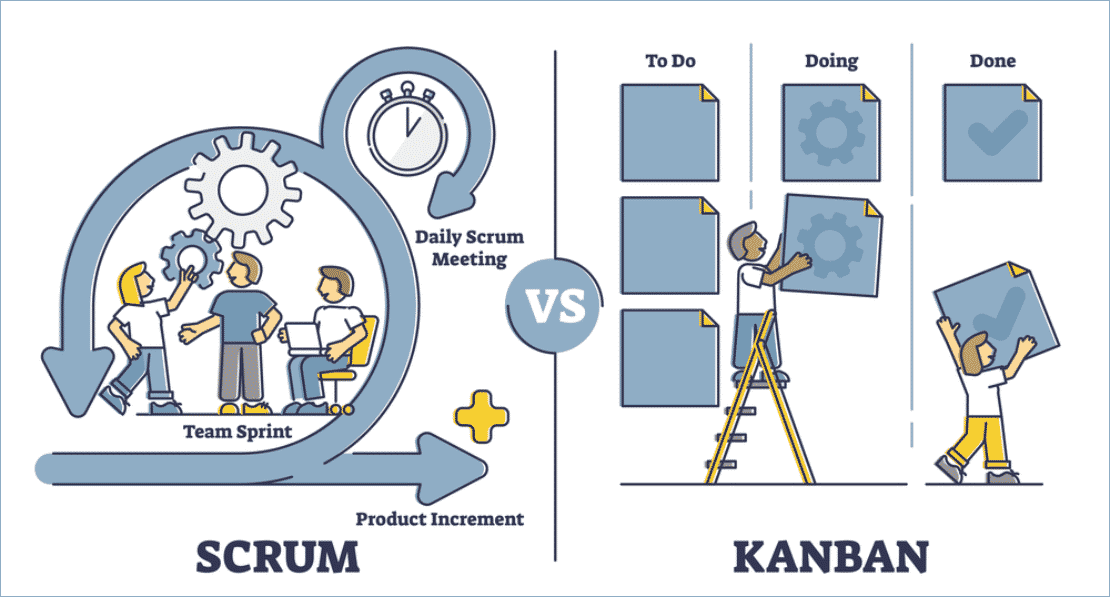
Jump ahead to
Kanban and Scrum in Agile Methodology
Agile project management consists of various agile frameworks that project managers can implement. The frameworks are designed based on the core principles of agile. Some of the agile frameworks used by organizations currently include Extreme Programming (XP), Scrum, Kanban, and Feature-Driven Development. Implementing Agile methodology has proven to assist organizations in faster delivery of projects, lower risks arising out of projects, and continuous improvement.
Scrum framework assist people as well as the organization in delivering value by designing customizable solutions. Implementing the framework requires the project team to assign a scrum master, a product owner, and scrum team. The framework of Kanban enhances project transparency by visualizing the project on boards. Project managers can apply Kanban even to an existing structure of the organization without any major changes. In addition, the illustrative approach of Kanban makes it easier for the project team to determine its progress. Let us have a look at the major differences between both frameworks.
Differences between Kanban and Scrum
Planning
Scrum framework relies on planning activities using sprint excessively. The most common tool used by project managers for carrying out project tasks is sprint. At the beginning of each iteration, project managers plan the activities that have to be carried out during each sprint. Various meetings are scheduled during each sprint to ensure that the project tasks are performed as planned without deviations.
Kanban Framework on the other hand is quite flexible. Applying kanban enables project professionals to make changes to the project while executing it. Project managers believe in lesser rigidity thereby incorporating changes as required frequently. The practice of continuous workflow permits project managers to extend the required section while modifying the tasks for a particular period.
Delivery
Applying scrum to projects enables individuals to design sprints and review the work completed at the end of each sprint. At the end of each sprint, clients can review the deliverables completed and check the progress of the project. This ensures that there are deviations from the course of project activities.
The Kanban method requires project managers to deliver products and processes continuously. Clients can place requests as required for deliverables. On the basis of these requests, project managers can plan their tasks to ensure that products or services are delivered on time.
Priority
Project managers applying the scrum framework need to complete the entire iteration before moving on to the next one. The team cannot perform new tasks unless the entire iteration is complete. This helps project managers to look and resolve any complex problems arising out of the project before taking up new tasks.
In the Kanban method, the project team can take up new tasks only after completing the previous task. Project managers apply a systematic workflow wherein the team can focus on current task at hand. Kanban framework is best suited for projects with stable priorities.
Roles
Scrum framework has predefined roles for the whole project team. The various roles performed by the scrum team include product owner, development team, and scrum master. The scrum team comprises members from different departments to assist in performing project-related tasks based on their expertise.
The Kanban method has no predefined roles for the project team. Kanban projects require a specialized team for carrying out project-related tasks. each individual can share the responsibilities of other team members to complete the project within the delivery date.
Measurement
Velocity gauges the progress of projects managed inside the scrum framework. Each sprint is consecutively aligned. This enables project managers to measure productivity levels based on the success of the previous sprint.
In the Kanban framework, project managers determine the productivity levels based on the time taken for completing a part of the project. In simple terms, this method of measuring the productivity of the team is known as the cycle time.
Modifications
Scrum framework discourages making changes to the project during sprint. Project managers do not make any last-minute changes to the project. Scrum masters disapprove requests to make changes to the ongoing iterations as it disrupts the entire progress of the project.
On the contrary, the Kanban method allows project managers to make changes during the project. Project managers can modify the iteration to incorporate the requirements requested by clients. This in turn assists project managers in continuously improving the project deliverables prior to completion.
Conclusion
Professionals can apply either of these frameworks based on the nature of the project at hand. There have been various instances wherein the scrum team has applied the Kanban principle for completing the projects. Various agile methods can be applied to the project based on the requirements and resources available. Individuals interested in broadening their knowledge on various agile frameworks can pursue PMI ACP Certification Training and acquire the credential. Pursuing ACP Certification enables professionals to master the skills and apply different agile methodologies while carrying out projects.



